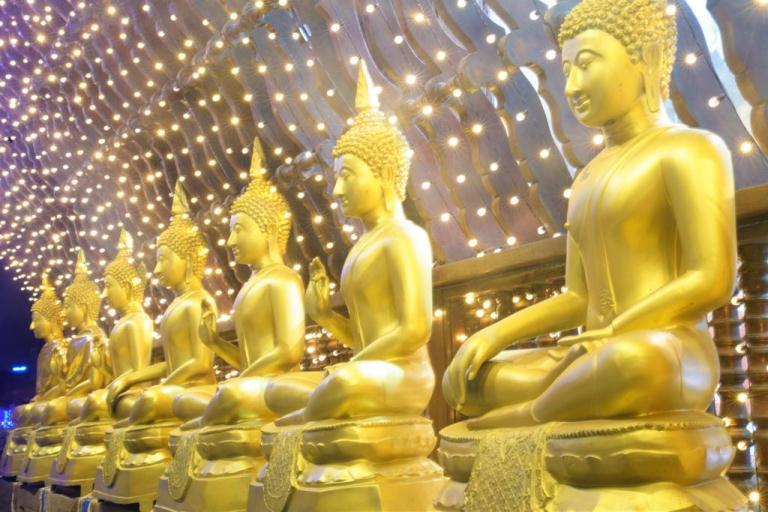Colombo, May 22 (newsin.asia/www.lanka.com): Though decorated pandols and colourful lights were not ubiquitous during “Vesak” this year unlike the past because of security considerations, some places like the Beira Lake in the Sri Lankan capital were lit up brilliantly and tastefully.
The lighting up greatly helped dispel the gloom which had enveloped the country after the multiple suicide bombings in Colombo and two other towns on April 21 in which 253 people were killed. The gloom was heightened by the subsequent anti-Muslim riots three weeks later which led to the destruction of about 500 Muslim properties and threatened to tear the inter-community social fabric apart.
In this context, the lighting up of the centre of Colombo on Vesak day – the day marking the birth, enlightenment and death of the Buddha, was like applying a soothing balm of a painful wound. And the choice of Beira Lake was right given the fact that it is a major tourist sport and is located near a famous Buddhist shrine, the Gangaramaya temple.
Beira Lake
Beira Lake is one of Colombo’s most famous landmarks. It lies right in the middle of the capital and is one of the few places of relaxation and beauty within the city limits. As such the area on and around it has many attractions; not to mention the history of the lake itself.
Beira Lake started out as a much bigger lake of occupying an area of 410 acres over a century ago. But with the rapid commercialization of the area it has since been reduced to approximately 160 acres. Beira was created by the invading Portuguese in the 1500s, in order to serve as a moat that protected their base in Colombo from the hostile locals. They added many hidden dangers within the lake, such as large crocodiles and etc.
Beira proved to be a huge roadblock to local sovereigns such as Mayadunne of Sitawaka, when they attempted to free the region from foreign rule. It was Mayadunne’s son, Rajasingha I, who succeeded in draining the lake in 1587, hence coming close to recovering the area from the Portuguese. He cut off the canals that fed the lake; but was unable to deal with the additional reinforcements that the Portuguese brought in from India.
After the Dutch laid siege and captured the lake; it was expanded and several islands were formed on it artificially. Some of them, such as Slave Island, were large enough to have a village and/or coconut plantations. People started inhabiting the islands and traffic over the water increased. However it was mostly used for political prisoners, as was the case in Slave Island, or agriculture; mainly due to the crocodiles that still infested the lake.
After the British took control they removed the crocodiles and developed the area surrounding the lake. The now grassy banks became popular for parties; and even hosted a grand ball that was held in celebration of Britain’s victory in the battle of Waterloo.
Beira lake became famous for a number of recreational activities, such as rowing and yachting.. Slave Island was cleared of its prison fixtures; and Ceylon’s first botanical garden, the Kew Gardens, was opened there in 1810. The seedlings were provided by the Royal Botanic Gardens in London. By the 19th century land reclamation for development began and the land area of the lake was reduced, pollution also began to increase.
Growth of Beira
About a decade ago the situation worsened to the extent that it was mostly surrounded by slums; while the water in the lake was purely wastewater from these huts and houses. The place stank and only the poorest people lived in the area. The waterfront was lined with many large warehouses, reminiscent Colombo’s tea trade; where tea was transported on barges to the port.
Then the government decided to redevelop the entire region. The slums were removed and the people moved to various government housing schemes; the lake was cleaned; good roads were laid out; skyscrapers and high end businesses started popping all over. The Rowing Club started growing once more as more people developed an interest in water activities. The area became an affluent commercial zone.

That was just the beginning. Long term projects were put into place to redevelop the islands as well. It is currently ongoing. The character of the entire neighbourhood will be changed dramatically by 2020. Slave Island is destined to become the entertainment and leisure center of Colombo. Even more spectacular skyscrapers, parks, resort hotels with shopping complexes, conference halls, convention centers and high-end residences are all slated to come in the near future. The government policy is aimed on promoting conference tourism, where both business travellers and holiday goers can enjoy themselves.
Gangaramaya Temple by the Lake
Gangaramaya is one of the oldest Buddhist temples in Colombo, started by the famous scholar monk Hikkaduwe Sri Sumangala Nayaka Thera in the late 19th Century. After the Venerable Sri Sumangala, his chief pupil Devundera Sri Jinaratana Nayake Thera took on the administration of the temple. It was he who laid the foundation to convert the little temple to an institute of international reckoning. The next chief incumbent was the Ven. Devundara Keerthi Sri Sumangala Jinaratana Vacissara Thera, the teacher of the Ven. Galboda Gnanissara, who worked to make the Gangaramaya what it is today: much more than a temple in the conventional term, but a place of worship, a seat of learning and a cultural centre.’
(Photos: Courtesy Tang Lu)




























































